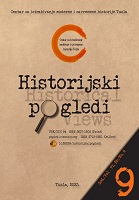THE EDUCATION OF ALBANIANS IN YUGOSLAVIA AFTER THE SECOND WORLD WAR UNTIL 1974.
THE EDUCATION OF ALBANIANS IN YUGOSLAVIA AFTER THE SECOND WORLD WAR UNTIL 1974.
Author(s): Kosovar BashaSubject(s): Political history, Social history, History of Education, State/Government and Education, WW II and following years (1940 - 1949), Post-War period (1950 - 1989), Sociology of Education
Published by: Centar za istraživanje moderne i savremene historije Tuzla
Keywords: Education; Yugoslavia; Albanians;
Summary/Abstract: The paper carefully deals with the constitutional aspect and the development of education in Yugoslavia, with special emphasis - Albanians. After the Second World War, Yugoslavia faced numerous problems both politically and economically. The first reforms that this country had to undergo initially required help from countries such as the Soviet Union. Among the first steps to be taken were the legislative reforms undertaken in 1946 by adjusting the Yugoslav Constitution. This constitution sanctioned important aspects of the political, economic, educational and cultural life of the country. The political life after the Second World War in Yugoslavia had undergone radical changes making it possible for countries like Macedonia to become independent states or to be created from scratch. The only country which was politically eliminated in this aspect was Kosovo, which was left under Serbia from 1945. By oppressing Kosovo politically in all aspects of life, Serbia exercised a segregationist policy towards the Albanian people of Kosovo. Harsh measures were exercised against the Albanian minority, including their relocation to Turkey through various Yugoslav-Turkish agreements, the imprisonment of many political personalities, etc. Political rights of expression were denied and political pressure continued at the national level. These forms were present continuously and did not stop until 1968 when the political situation began to change. Indeed, the Albanian minority in Yugoslavia made good use of the political circumstances after 1968 when, in general demonstrations in all the cities of Kosovo, they opted for more national rights and requested the establishment of the University of Prishtina. Non-Albanian minorities were included in the Yugoslav republics in all spheres of life. Since they were not in large numbers, their presence was not revealed apart from the Hungarians. The Hungarian minority also began to enjoy greater rights with the amendment of several articles of the constitutions of 1946, 1953, 1963 and 1974. The presence of Hungarian schools was evident with several such schools and a lot of students who were allowed to use and be instructed in their mother tongue. Other small minorities such as Russians, Bulgarians, Germans and others were few in number. The Albanian population in Yugoslavia was distributed across several republics such as Serbia, Kosovo, Macedonia, Montenegro and to a lesser extent Croatia and Slovenia. Political power in Yugoslavia which was largely led by Serbs until 1966 through the iron hand of Alexander Rankovic did not allow the Albanians to even use their national flag and to express any kind of dissatisfaction through various demonstrations or manifestations. The period between 1966-1974 was decisive for Albanians in Yugoslavia, especially since many important steps were taken in political terms, such as the replacement of Serbian politicians with Albanians, the establishment of many different schools and the massification of higher education in general. The Yugoslav constitutions with their reforms changed the direction of comprehensive development of political, social, economic and cultural life for all non-Albanian and Albanian minorities in Yugoslavia. The author has followed the descriptive and analytical scientific methods for dealing with this important issue for general historiography. A serious Yugoslav and Albanian literature covering this socially and scientifically important study has been used.
Journal: HISTORIJSKI POGLEDI
- Issue Year: VI/2023
- Issue No: 9
- Page Range: 205-224
- Page Count: 20
- Language: English

